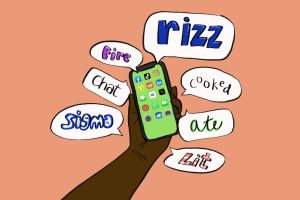Column: How do you imagine the future?
Photo credit: Sydney Frank
Depicted in this illustration is a futuristic, “cyberpunk” city. In media, aesthetics like this one often use Asian culture in harmful ways, something that is known as techno-orientalism.
March 17, 2023
If I asked you what you thought the future would look like in a thousand years, I could probably guess what you’d say – extremely advanced technology, some sort of post-apocalyptic storyline and maybe even a zombie or two.
Different types of science fiction works have placed this image in our heads, stemming from genres such as dystopian and cyberpunk to apocalyptic and post-apocalyptic. I mean, I don’t know about you but stories like “Maze Runner,” “Ready Player One” and “Hunger Games” fulfilled my childhood, and it’s still one of my favorite genres to read today.
What most people don’t think about though, is the underlying Asian influence on these genres — cyberpunk, in particular.
“The origins of the cyberpunk genre involve Western anxieties about the East,” George Yang said, a writer for the magazine Wired. “Techno-orientalism is the use of Asian aesthetics in cyberpunk, futuristic and dystopian settings. There is a long and deep Euro-American tradition of using Asian symbolism such as neon signs with Japanese and Chinese lettering to express those feelings about what the future holds, including globalization and the threat of a takeover from the East.”
Extremely renowned films such as “Blade Runner,” “The Matrix,” “Ghost in the Shell (2017)” and “Bullet Train” fall into this trap, as well as current popular video games. In her column this month, Paulina DePaulo discusses one of these games, called “Stray.” If you want to learn more, I highly suggest checking her piece out.
Techno-orientalism in media can refer to Yang’s definition or even just the notion that anything “Asian” is synonymous with anything technologically advanced.
This idea is not inherently racist, but once you start to look beyond these aesthetically designed neon signs depicting various Asian languages or settings that look suspiciously similar to prominent Asian cities, the many undertones of orientalism come to light.
If you do not know orientalism is a concept referring to the “allegedly simplistic, stereotyped, and demeaning conceptions of Arab and Asian cultures generally held by Western scholars” and was popularized by Edward Said in the late 20th century.
“The Orient was not (and is not) a free subject of thought or action…European culture gained in strength and identity by setting itself off against the Orient as a sort of surrogate and even underground self,” Said wrote.
In saying this, Said mystifies the Orient and glorifies Europe, thus fueling the ideas behind the tech-orientalism we see so often in media today. Asian culture is often “othered” within these stories; Asian technology is created for the West to fight against, and Asians are deemed uncivilized because the West fears them.
Chloe Gong, one of my favorite Asian-American authors, put it best when she wrote, “While 19th century Europe sipped tea and spoke of the ‘savages’ out in the unconquered world, 21st century America consumes news article after news article about Chinese takeovers of American factories and jobs, Japanese technology light years ahead, North Korean missiles within range for firing. Techno-orientalist tropes bloom from anxieties and fears of a dying American dominance, and in a world where America struggles to understand its place in the world …, the futures being written into fiction equate bleak with Asian.”
Now, I don’t think any of the films or games I mentioned previously are inherently racist, or even intended to come off that way; techno-orientalism has just become such a norm in the sci-fi realm that many willfully or even ignorantly choose to ignore the unpleasant connotations. These films and stories just cannot be allowed to vilify ALL of Asia into some counterpart for Western Society to fear and fight against.
Disney’s “Big Hero Six” is the perfect example of a story that is evidently Asian-influenced but stays away from the fine line of techno-orientalism, as it centers on predominant Asian characters.
Filmmakers and authors who want to use Asian-inspired themes and scenery in their stories should take this into account and understand how to appreciate Asian culture without perpetuating undesirable narratives.









